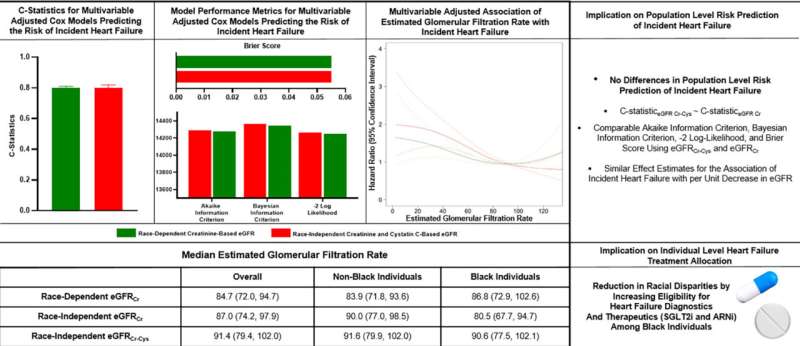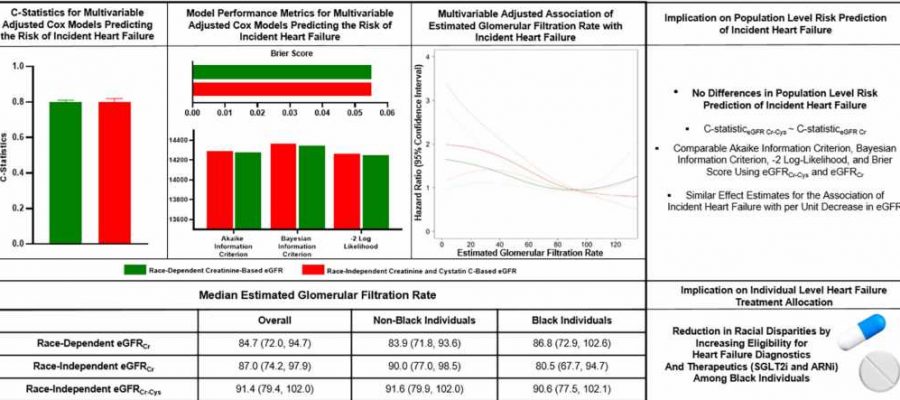
Physician-scientists from the University of Alabama at Birmingham Marnix E. Heersink School of Medicine recently conducted a large-scale analysis to assess the impact of a newly introduced equation used to evaluate one’s heart failure risk. The study, published in the Journal of Cardiac Failure, showed that the new and old kidney function equations had comparable values in predicting the risk of heart failure.
Naman Shetty, M.D., a clinical research fellow in the UAB Division of Cardiovascular Disease and the first author of this manuscript, explained that since kidney function cannot be measured directly, equations were created to measure kidney function using the circulating levels of waste products such as creatinine. Creatinine is a chemical waste product of creatine, a substance that is used to supply energy to the muscles. Prior to the new equation, an adjustment for race was used in the equation to account for racial differences in the creatinine levels in the blood. However, Shetty says the inclusion of race in the previous equation was criticized for potentially promoting racial disparities in health care.
“In an attempt to reduce these disparities, the National Kidney Foundation introduced the race-independent equation to estimate kidney function,” Shetty said. “This race-free equation uses the levels of two substances (creatinine and cystatin C) to estimate kidney function and was shown to be more accurate than the previous equation.”
Heart failure affects about 6.2 million adults in the United States and costs the nation approximately $30.7 billion for health care services, medications and missed days of work, according to the Centers for Disease Control and Prevention. Poor kidney function is known to be a risk factor of heart failure. Shetty and his team analyzed data from approximately 16,000 individuals of two large prospective U.S. population cohorts, including the Atherosclerosis Risk in Communities and Multi-Ethnic Study of Atherosclerosis. These participants were assessed for their kidney function and followed up for a decade. This allowed researchers to compare the risk prediction value of the new and old kidney function equation for heart failure.
Shetty and his team showed that both kidney function equations were comparable in their ability to predict the risk of developing heart failure. The new kidney function equation has been deemed more accurate at estimating kidney function in Black individuals than the old equation.
“Several lifesaving drugs that reduce the risk of death from heart failure require kidney function to be adequate to administer the medication safely,” said Pankaj Arora, M.D., the senior author of the manuscript, an associate professor in the UAB Division of Cardiovascular Disease and cardiologist at the UAB Cardiovascular Institute. “The previous equation was known to generate lower estimates of kidney function in Black individuals, which made them ineligible for heart failure therapies. Widespread adoption of the new kidney function equation will increase the eligibility of heart failure therapeutics in Black individuals. This will help reduce the racial disparities in cardiovascular disease by reducing the risk of poor outcomes in Black individuals.”
This analysis was done in collaboration with the University of Minnesota, the University of Texas Southwestern Medical Center, Emory University and Washington University in St. Louis.
More information:
Naman S. Shetty et al, Incident Heart Failure Risk Reclassification with Race-Independent Estimated Glomerular Filtration Rate: An NHLBI Pooled Cohorts Analysis, Journal of Cardiac Failure (2023). DOI: 10.1016/j.cardfail.2023.07.009
Journal information:
Journal of Cardiac Failure
Source: Read Full Article
